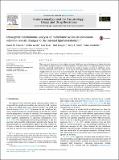Files in this item
Untargeted metabolomic analysis of miltefosine action in Leishmania infantum reveals changes to the internal lipid metabolism
Item metadata
| dc.contributor.author | Vincent, I.M. | |
| dc.contributor.author | Weidt, S. | |
| dc.contributor.author | Rivas, L. | |
| dc.contributor.author | Burgess, K. | |
| dc.contributor.author | Smith, T.K. | |
| dc.contributor.author | Ouellette, M. | |
| dc.date.accessioned | 2014-05-13T13:31:01Z | |
| dc.date.available | 2014-05-13T13:31:01Z | |
| dc.date.issued | 2014-04 | |
| dc.identifier | 118160928 | |
| dc.identifier | ec28932e-1869-49d4-9025-c62eb3c6525a | |
| dc.identifier | 84890194600 | |
| dc.identifier | 24596665 | |
| dc.identifier | 000331708400003 | |
| dc.identifier.citation | Vincent , I M , Weidt , S , Rivas , L , Burgess , K , Smith , T K & Ouellette , M 2014 , ' Untargeted metabolomic analysis of miltefosine action in Leishmania infantum reveals changes to the internal lipid metabolism ' , International Journal for Parasitology: Drugs and Drug Resistance , vol. 4 , no. 1 , pp. 20-27 . https://doi.org/10.1016/j.ijpddr.2013.11.002 | en |
| dc.identifier.issn | 2211-3207 | |
| dc.identifier.uri | https://hdl.handle.net/10023/4775 | |
| dc.description | This work was funded by the Canadian Institutes of Health Research (Grant number 13233). The Polyomics facility at the University of Glasgow is funded by The Wellcome Trust and the Scottish Universities Life Science Alliance. L.R. is funded by Ministerio de Economía y Competitividad (FIS PI 12-02706). T.K.S. is supported by a Wellcome Trust Grant 093228. | en |
| dc.description.abstract | There are many theories as to the mode of action of miltefosine against Leishmania including alterations to the membrane lipid content, induction of apoptosis and modulation of macrophage responses. Here we perform untargeted metabolomics to elucidate the metabolic changes involved in miltefosine action. Over 800 metabolites were detected, 10% of which were significantly altered after 3.75. h. Many of the changes related to an increase in alkane fragment and sugar release. Fragment release is synchronised with reactive oxygen species production, but native membrane phospholipids remain intact. Signs of DNA damage were also detected as were changes to the levels of some thiols and polyamines. After 5. h of miltefosine treatment the cells showed depleted levels of most metabolites, indicating that the cells' outer membrane integrity had become compromised and internal metabolites were escaping upon cell death. In miltefosine resistant cells, the drug was not internalised and the changes to the internal metabolite levels were not seen. In contrast, cells resistant to antimony (SbIII) had similar corresponding alterations to the levels of internal metabolites as wild-type cells. A detailed knowledge of the mode of action of miltefosine will be important to inform the design of combination therapies to combat leishmaniasis, something that the research community should be prioritising in the coming years. | |
| dc.format.extent | 8 | |
| dc.format.extent | 1234410 | |
| dc.language.iso | eng | |
| dc.relation.ispartof | International Journal for Parasitology: Drugs and Drug Resistance | en |
| dc.subject | Miltefosine | en |
| dc.subject | Leishmania | en |
| dc.subject | Metabolomics | en |
| dc.subject | Mode of action | en |
| dc.subject | RM Therapeutics. Pharmacology | en |
| dc.subject.lcc | RM | en |
| dc.title | Untargeted metabolomic analysis of miltefosine action in Leishmania infantum reveals changes to the internal lipid metabolism | en |
| dc.type | Journal article | en |
| dc.contributor.sponsor | The Wellcome Trust | en |
| dc.contributor.institution | University of St Andrews. School of Biology | en |
| dc.contributor.institution | University of St Andrews. Biomedical Sciences Research Complex | en |
| dc.identifier.doi | https://doi.org/10.1016/j.ijpddr.2013.11.002 | |
| dc.description.status | Peer reviewed | en |
| dc.identifier.url | http://www.scopus.com/inward/record.url?eid=2-s2.0-84890194600&partnerID=8YFLogxK | en |
| dc.identifier.grantnumber | 093228/Z/10/Z | en |
This item appears in the following Collection(s)
Items in the St Andrews Research Repository are protected by copyright, with all rights reserved, unless otherwise indicated.

